This post may contain affiliate links. Please read our disclosure policy.
Sourdough shokupan represents a harmonious fusion of Japanese bread-making traditions and the art of sourdough fermentation. This sourdough shokupan offers a unique twist on the classic, delighting both bread enthusiasts and those seeking a healthier and more flavorful option.

I keep a log of my sourdough feeding schedule and activity and today is 365 days since I have baked with my faithful robust starter! Happy birthday my little starter (that I have yet to name to this date!). It feels like I have baked with it for a long time but it’s been only a year. I had baked over 300+ of sourdough bread in this one year. That includes rustic artisan, enriched sweet or savory bread, steamed buns, and anything in between.
No Sour Sourdough Bread
This recipe will give you sourdough bread that doesn’t taste sour. Why? Because we use a sweet stiff starter, which is built from a regular 100% hydration sourdough starter. Ever since I learned how to bake enriched bread using sweet stiff starter, I hardly ever bake using a regular liquid starter. It just takes too long for me when it comes to enriched bread. I love the shreddy and soft texture when I use sweet stiff starter.
What is a sweet stiff starter?
In sourdough baking, a sweet stiff starter refers to a type of sourdough starter that is maintained with a higher ratio of flour to water or milk and contains sweeteners such as sugar or honey. Unlike the more common liquid or semi-liquid sourdough starters, a stiff starter has a firmer consistency, similar to dough. I don’t maintain a sweet stiff starter. I build it using my regular liquid starter whenever I need it. So I just maintain my regular liquid starter. I love baking enriched bread/buns and steamed buns using a sweet stiff starter.
Sourdough Shokupan/Milk Bread (with Sweet Stiff Starter)
Ingredients
Option 1: Sweet stiff starter (peak in 8-10 hours):
- 55 g active starter (100% hydration)
- 165 g bread flour (12.7% protein content)
- 65 g water
- 30 g sugar
Option 2: Sweet stiff starter (peak in 4-6 hours):
- 115 g active starter (100% hydration)
- 115 g bread flour (12.7% protein content)
- 45 g water
- 25 g sugar
Final dough with option 1:
- 133 g bread flour (12.7% protein content) or more as needed
- 90 g whole milk or more as needed
- 12 g milk powder
- 45 g sugar
- 5 g salt
- 32 g unsalted butter softened
Final dough with option 2:
- 153 g bread flour (12.7% protein content) or more as needed
- 90 g whole milk or more as needed
- 12 g milk powder
- 45 g sugar
- 5 g salt
- 32 g unsalted butter softened
Egg wash (if you bake the bread in a pan without the lid)
- 1 egg beaten
- 1 tsp milk
Instructions
- I use a 7 1/2 x 4 1/2 x 4 1/2 small but tall loaf pan. You can also use 8 1/2 x 4 1/2 loaf pan, the loaf will come out shorter but wider
Prepare sweet stiff starter:
- I recommend using a starter that is at least two months old and consistently doubles or triples in 4-6 hours when you feed it at 1:1:1 ratio. Young starter will not give the best result
- Combine all ingredients for the sweet stiff starter in a bowl. Stir a bit to roughly combine and then use your clean hand to knead it. This is a stiff starter, it's like a dough. Make sure no pockets of dry flour are visible. Transfer to a large see-through container (plastic or glass is fine, preferably wide-mouth so you can get it out easier later). Loosely cover with the lid and let it ferment until triple in size
Prepare the dough:
- Place all ingredients and the stiff starter, except for the butter, in a mixing bowl of a stand mixer fitted with a dough hook attachment. Use the hook to stir everything around a bit so when you turn the machine on, the flour won't fly around and wet ingredients won't splash (it happened to me before!).
- Start with the lowest speed to mix things up and then increase to speed 2 and knead for about 5 minutes or until it forms a dough. If the dough is too dry to come together, you can add a bit of milk one teaspoon at a time. Don't add too much as we haven't added the butter yet
- Then add butter in 2-3 batches. The dough will turn into a complete mess again because of the butter, but don't worry, it will get absorbed by the dough as it kneads. Knead at speed 4 for about 10 minutes or until the dough is smooth and elastic. If you slowly stretch a small amount of dough, it will not break and light can pass through, like a window pane. Proceed to first proofing
First proofing:
- Transfer to a lightly oiled bowl, cover, and proof at a warm place for about 1 1/2 – hours max at 78-82 F (26-28 C), the dough will not double in size. It probably rises only about 25%, which is fine. Sourdough starter is different from commercial yeast.
Shaping:
- Lightly grease your loaf pan on all sides
- Punch the dough down and give it a knead for a few times. Divide into 2 or 3 equal-weight doughs. Round up each dough to roughly form a ball. Cover and let them rest for 10 minutes
- Then work with one dough at a time and keep the rest covered. Flatten the dough with your palm and roll it into a rectangle shape, the width should about twice the width of the loaf pan and about the same length as the loaf pan. Fold the two sides over to meet in the middle and then roll the dough up, not too tight, not too loose, like a Swiss roll
- Place the shaped dough into the pan. Repeat with the other dough. Place all the shaped dough side by side inside the loaf pan. Slightly flatten the three doughs with your palm so they are about the same height
Final proofing:
- Cover and let the dough proof again at a warm place until it fills up about 80-90% of the pan. This may take about 3-4 hours or longer at 82 F (28 C). Mine usually takes about 3-3 1/2 hours. If you want to bake with the lid, slide the lid now before the dough rises too high and you won't be able to use the lid anymore
- If you bake in a pan without the lid, brush the surface of the dough with an egg wash
Baking:
- 10 minutes before the end of proofing, preheat your oven to 375 F (190 C) for a conventional oven. For convection top and bottom heat, lower the temperature by 20 F or 15 C
- Place the loaf pan on the middle rack and bake for 30 minutes or until the top is golden brown if you bake without the lid. UPDATED: If you bake with the lid, bake for 30 minutes and then lower the temperature to 350 F (180 C) for conventional oven and bake for another 5 minutes or until internal temperature is 190 F (88 C)
Cooling:
- Once out of the oven, drop the pan on the counter to release some steam and immediately remove from the pan onto a cooling rack. Optional: If you want a softer shinier crust, you can brush with melted butter immediately while the bread is still warm. Let the bread cool down completely on the rack
Storing:
- Once it has cooled down, you can put in an air-tight container and can be kept at room temperature for 2-3 days. The bread should stay soft for few days if kept properly at room temperature
RECOMMEDED TOOLS
*Nutrition facts are just estimates and calculated using online tools*
Benefits of baking enriched bread with sweet stiff starter
The main benefit of using a sweet stiff starter is that it tends to produce a milder and sweeter flavor profile in sourdough bread. This can be particularly desirable when making bread with a delicate taste, such as brioche, or enriched sweet bread like shokupan. The sweet stiff starter also shortens the fermentation time compared to when you use a liquid starter to prepare the enriched dough, but still full of complex flavor that I can’t seem to get enough!

How to bake sourdough shokupan with sweet stiff starter
1. Combine all ingredients for the sweet stiff starter in a bowl. Stir a bit to roughly combine and then use your clean hand to knead it. This is a stiff starter, it’s like a dough. Make sure no pockets of dry flour are visible. Transfer to a large see-through container (plastic or glass is fine, preferably wide-mouth so you can get it out easier later). Loosely cover with the lid and let it ferment until triple in size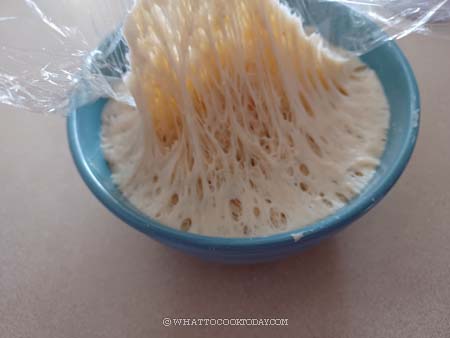
2. Place all ingredients and the stiff start, except for the butter, in a mixing bowl of a stand mixer fitted with a dough hook attachment. Use the hook to stir everything around a bit so when you turn the machine on, the flour won’t fly around and wet ingredients won’t splash (it happened to me before!).
3. Start with the lowest speed to mix things up and then increase to speed 2 and knead for about 5 minutes or until it forms a dough. If the dough is too dry to come together, you can add a bit of milk one teaspoon at a time. Don’t add too much as we haven’t added the butter yet
4. Then add butter in 2-3 batches. The dough will turn into a complete mess again because of the butter, but don’t worry, it will get absorbed by the dough as it kneads. Knead at speed 4 for about 10 minutes or until the dough is smooth and elastic. 
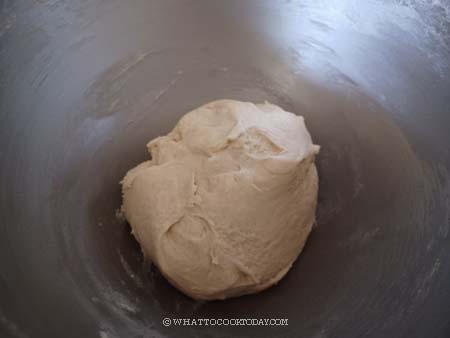
5. If you slowly stretch a small amount of dough, it will not break and light can pass through, like a window pane. Proceed to first proofing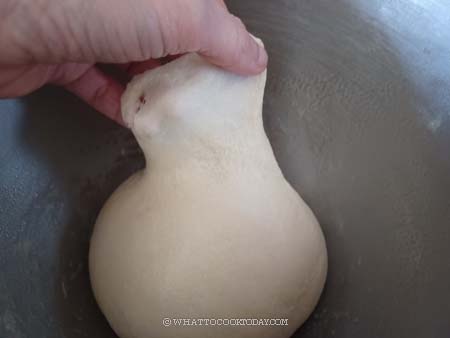
6. Transfer to a lightly oiled bowl, cover, and proof at a warm place for about 1 1/2 – hours max at 78-82 F (26-28 C), the dough will not double in size. It probably rises only about 25%, which is fine. Sourdough starter is different from commercial yeast.
7. Lightly grease your loaf pan on all sides. Punch the dough down and give it a knead for a few times. Divide into 2 or 3 equal weight smaller doughs. Round up each dough to roughly form a ball. Cover and let them rest for 10 minutes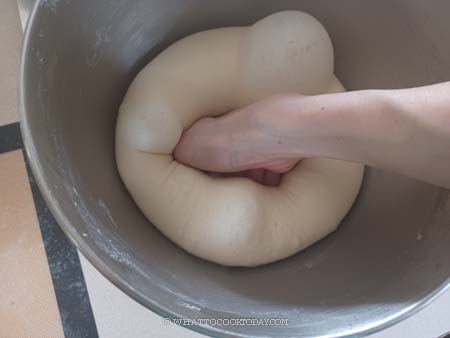
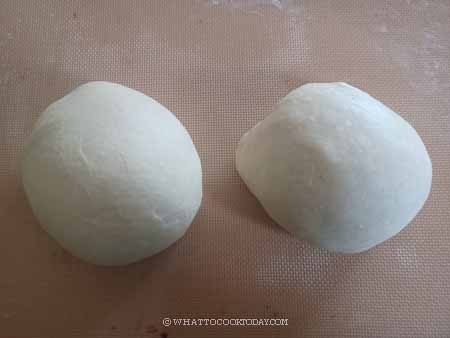
8. Then work with one dough at a time and keep the rest covered. Flatten the dough with your palm and roll it into a rectangle shape, the width should be about twice the width of the loaf pan and about the same length as the loaf pan. Fold the two sides over to meet in the middle and then roll the dough up, not too tight, not too loose, like a Swiss roll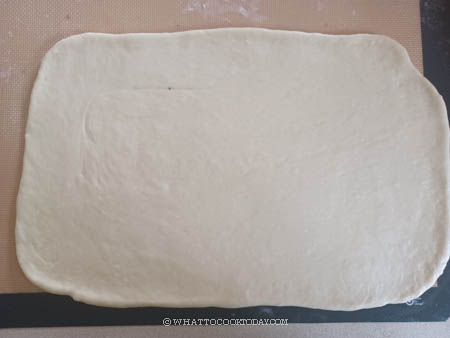

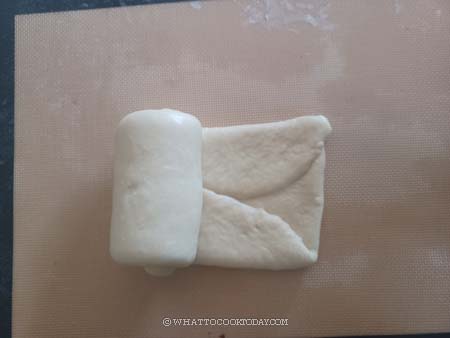

9. Place the shaped dough into the pan. Repeat with the other dough. Place all the shaped dough side by side inside the loaf pan. Slightly flatten the three doughs with your palm so they are about the same height
10. Cover and let the dough proof again at a warm place until it fills up about 80-90% of the pan. This may take about 3-4 hours or longer at 82 F (28 C). If you want to bake with the lid, slide the lid now before the dough rises too high and you won’t be able to use the lid anymore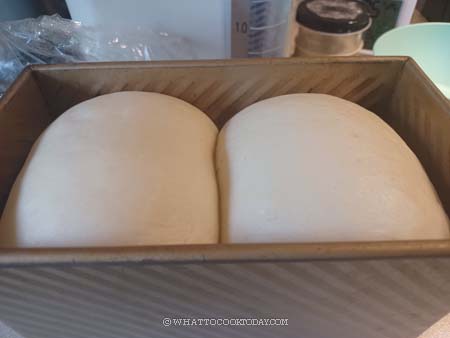
11. 10 minutes before the end of proofing, if you bake without the lid, preheat your oven to 375 F (190 C) for conventional oven and lower temperature by 20 F or 15 C for convection oven
12. If you bake without the lid, brush some egg wash on the surface of the dough. Place the loaf pan on the middle rack and bake for 30 minutes or until the top is golden brown if you bake without the lid. UPDATED: If you bake with the lid, bake for 30 minutes and then lower the temperature to 350 F (180 C) for conventional oven and bake for another 5 minutes or until internal temperature is 190 F (88 C)
13. Once out of the oven, drop the pan on the counter to release some steam and immediately remove from the pan onto a cooling rack. Optional: If you want a softer shinier crust, you can brush with melted butter immediately while the bread is still warm. Let the bread cools down completely on the rack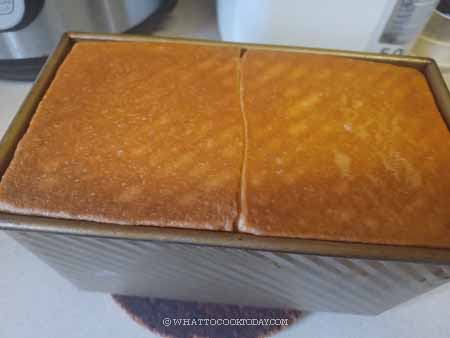
14. Once it has cooled down, you can put in an air-tight container and can be kept at room temperature for 2-3 days. The bread should stay soft for a few days if kept properly at room temperature

Look at the dreamy soft fluffy crumbs

Did you make this sourdough shokupan using sweet stiff starter recipe?
I love it when you guys snap a photo and tag it to show me what you’ve made. Simply tag me @WhatToCookToday #WhatToCookToday on Instagram and I’ll be sure to stop by and take a peek for real!




36 comments
How do I convert yeast recipe to adopt sweet stiff starter? Thanks much!
Hi Joey, I still have TONS to learn about sweet stiff starter and not sure if I’m the right person to ask about conversion from yeast to SSS. In general I just kinda use about 9-10% of liquid starter from the amount of total flour. Then after that I decided whether I will do 1:1 ratio (peak faster), which is one part starter, one part flour or 1:3 ratio (peak slower). The hydration is usually 30-40% of flour used to build the SSS. I supposed there’s a formula for that, but I just kinda adapt from what’s already out there. Chiew See from Autumn Kitchen is where I learned about SSS. She posted lots of tips on SSS on her IG if you don’t know already https://www.instagram.com/autumn.kitchen/
Enak banget rotinya ini Kakak, saya coba pakai opsi 2. walaupun waktu pembuatannya lumayan lama :).
Terima kasih resepnya. Sukses ya Kak Marvellina.
Hi Agnis, Yay!!! senang aku baca komennya 🙂 Iya sih, sourdough memang agak lama ya bikinnya tapi aku suka rasanya! thank you ya udah nyobain!
This is a fantastic recipe! It’s my favorite for soft and delicious sandwich bread.
Hi Linda! I’m happy to know that you enjoyed this soft bread! It’s one of our family’s favorites too! 🙂
Hi, what happens if i omit the sugar? My sour dough rise perfectly fine without it. Does it change the final texture? Or is it just sweetness? I don’t want any sweetness. Cheers, luca
Hi Luca, you can omit the sugar in the dough, but please don’t omit the sugar in the stiff starter. The sugar in the stiff starter will not impart any sweetness to the final product. It’s not going to change the final texture if you omit the sugar in the dough, just the taste.
Hello Marvellina,
I love the details step by step to make the Shokupan. I have a question…..I prepared sweet stiff starter in advance and stored in the fridge. Can I take out use it right out from the fridge without feeding (as my sweet stiff starter continues growing slowly in its dormant stage)?
If so, how much sweet starter should I add to make a loaf of Shokupan? Thanks for your comments
Hi Karen,
I usually tried to use it within 12 hours if I really can’t get to it any sooner (I rarely do that!). In general, I usually use the SSS as soon as possible in less than 3-4 hours after it peaks. The reason why we use SSS instead of liquid starter because it helps to reduce the sourness especially in enriched bread like this as it works much faster than liquid starter and also I like how it produces shreddy crumbs. So by using a long past-peak SSS kinda defeats the purpose as it may not perform as it is intended to be.
I recommend to prepare SSS only when you need to and don’t prepare ahead.
I’m not sure what formulation you use to built your SSS so I can’t tell you how much SSS to use for this recipe because the hydration may be different